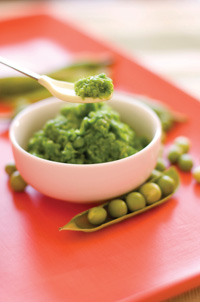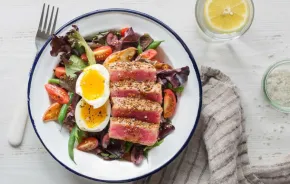 “You make your own baby food?” a puzzled mom asks me.
“You make your own baby food?” a puzzled mom asks me.
“Yes, it’s no big deal,” I say.
“But aren’t you busy?”
Busy? Yes! I have two jobs and a baby . . . and I still have time to make baby food! It’s not that hard.
Most of the moms I’ve met seem to think there’s some kind of mystique to those little glass jars. But I make my own baby food, and here’s my secret: It’s cheap, quick and easy. Anyone with a stove, a blender and a freezer can do it.
Homemade vs. jarred
“People never think of [making baby food],” says Edmonds physician Ann Begert. “It’s healthier; you can use better stuff, and it tastes better.” That’s because commercial processing takes the flavor out of baby food, Begert says. “Have you ever tasted it? It doesn’t taste good. I don’t know how babies eat it.”
Feeding guidelines for homemade baby food are the same as for jarred, says Begert. “I tell people to start with rice cereal, but then they can use fruits and vegetables.” Begert suggests parents feed babies green vegetables so they develop a taste for them. For picky eaters, lean toward sweeter foods, which kids tend to like more readily.
Do you need to go organic? Not necessarily, according to Begert. Organic produce costs more, and may not be necessary. “We don’t have good data about what bad things are in [nonorganic] food,” Begert says. “Organic is preferential if you can afford it, but it’s not the end of the world if you can’t.” The rule of thumb for choosing conventionally farmed produce over organic starts with considering the thickness and edibility of the skin. In general, it’s best to buy organic thin-skinned or edible-skinned produce. Thick-skinned produce doesn’t tend to absorb as many chemicals into the edible part of the fruit.
How to make it
To make baby food, start with fresh or frozen vegetables. Frozen organic veggies are cheaper and easier to use than fresh, and they retain most of their nutrients in the freezing process, according to the Department of Agriculture. Plus, they don’t require much cooking because they’re already fairly soft. Fresh vegetables typically have more nutrients, but require a little more work (washing, chopping, etc.).
To begin, prep fresh vegetables for cooking or open a package of frozen veggies. Steam vegetables in a steam basket or microwave in an inch of water, covered with a wet paper towel until soft. Once they’re cooked, drain them; pop them in the blender or food processor and purée. If you use a blender, you may need to add a little water to make a smoother purée. Voila! Ready to eat.
Here’s a nifty trick for preserving leftovers: Pour them into an ice cube tray and freeze, then pop out the cubes and store in a freezer bag. Each cube makes a nice little serving.
 Watching for allergies
Watching for allergies
As you introduce a new food, offer it for all meals, for three or four days in a row, Dr. Begert advises. That way, if your child has an allergic reaction to a food — signs include a rash, diarrhea and fussiness — you’ll be able to easily tell which food it is.
The most common food allergens are strawberries, nuts, eggs and milk, says Begert. “That’s why we don’t feed them to kids until they’re a year old.” Allergies are also the reason doctors don’t recommend feeding solids to babies younger than 6 months. And parents with family histories of food allergies should be more prudent. “If you have a severe nut allergy in the family, don’t test it at home,” Begert says. Doctors are more than willing to test children at risk for severe allergies in the examination room.
As baby grows, you can skip the blender and cut cooked vegetables or fruit into small pieces as needed. Pieces should be smaller than half of a peanut, says Begert, to avoid choking.
Maria Bellos Fisher is a freelance writer, blogger and baby food chef. Find her blog, Hereditary Insanity, at mariabellosfisher.com/blog.
Sweet treats
Sweet potatoes and butternut squash can be sweet treats for baby. Squash can be steamed, but roasting it in the oven will concentrate the sugars. For butternut squash, halve the squash, scoop out seeds, lay skin side up on a greased cookie sheet and bake for one hour. Squash is done when a fork pierces skin and flesh easily. Remove skin and purée.
For sweet potatoes, pierce skin several times and bake on a pan at 350 degrees for one hour (or less for smaller potatoes). They’re ready when they feel soft and the skin separates easily from the flesh. Remove skin and purée.
More tips on making homemade baby food.











